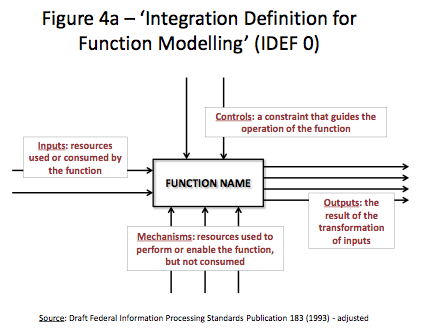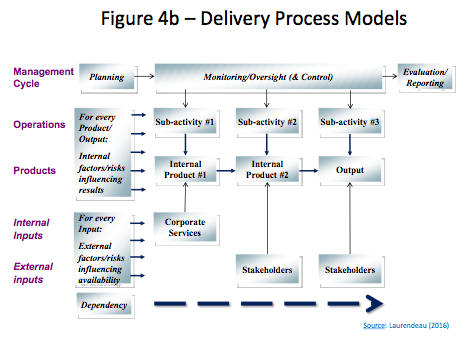Hello, my name is Michel Laurendeau, and I am a consultant wishing to share over 40 years of experience in policy development, performance measurement and evaluation of public programs. This is the fourth of seven (7) consecutive AEA365 posts discussing a stepwise approach to integrating performance measurement and evaluation strategies in order to more effectively support results-based management (RBM). In all post discussions, ‘program’ is meant to comprise government policies as well as broader initiatives involving multiple organizations.
This post articulates the approach to the development of delivery process models that ventilate the individual activity-output sequences of a logic model in order to allow for the management oversight and control of program implementation.
Step 4 – Including Delivery Processes
Delivery process modelling can easily be accomplished by adapting a computer-assisted Integrated Definition (IDEF) methods developed in the ‘90s by the National Institute of Standards and Technologies (NIST). The IDEF 0 function modelling was initially based on authority links of controls ensuring that activities of multiple players are coordinated and undertaken only when proper authorities have been issued. In the IDEF 0 model, inputs and support mechanisms are used to perform operations and produce outputs through operations or transformation processes that are subjected to management controls and oversight (see Figure 4a). These nodes can be detailed further (by digging into the steps of each function) and/or sequenced to provide an exhaustive view of all program operations.
The delivery process model presented in Figure 4b is an adaptation of the IDEF 0 approach that is achieved by redefining operations and mechanisms as successive sub-activities supported by various players and stakeholders, with distinct products that are delivered at each step of production and that are subject to direct management authority (i.e. oversight and control). The final step is then the one that actually generates the product (or service) that is being identified as the output of a specific activity in the logic model.
In this modelling approach, inputs are not used to define consumed resources (e.g. funds and human resources), but rather to identify the mechanisms and sources of support for program delivery. Further, since delivery is done in a strict stepwise manner, the strong conditionality between sub-activities can actually be redefined as dependencies. The model also makes it possible to take into account internal and external factors/risks that can have an influence on delivery at each step of production.
The above model is essentially a working tool to help analysts validate their understanding of delivery processes. In performance measurement frameworks, the description of the process models can actually be limited to the sequence of operations and their related products in the narrative of each activity of the logic model, with a view to support the identification of indicators for monitoring purposes.
Figure 4b already suggests how to position the management cycle in relation with program delivery processes, and how best to articulate management issues from a program perspective. The next AEA365 post will address these features in greater detail.
Do you have questions, concerns, kudos, or content to extend this aea365 contribution? Please add them in the comments section for this post on the aea365 webpage so that we may enrich our community of practice. Would you like to submit an aea365 Tip? Please send a note of interest to aea365@eval.org . aea365 is sponsored by the American Evaluation Association and provides a Tip-a-Day by and for evaluators.


